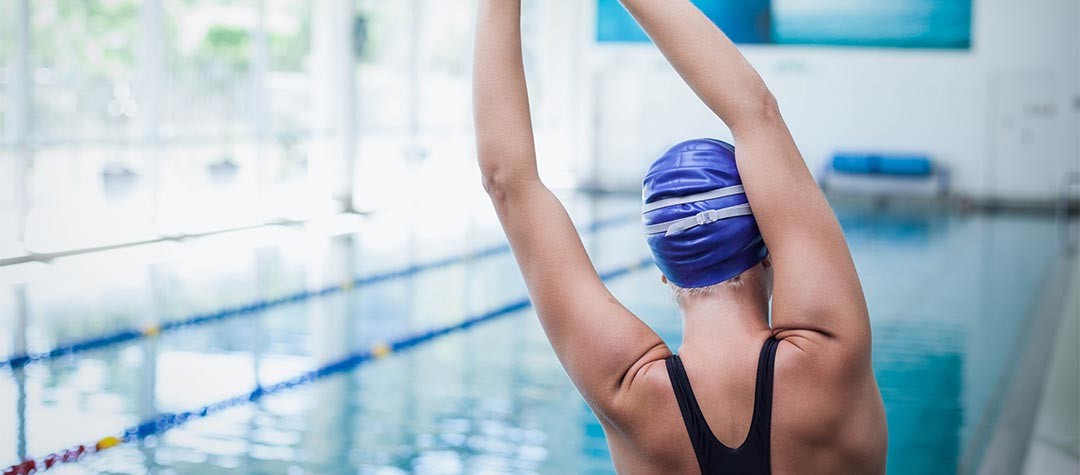Like all physical activity, swimming comes with its injury risks. Stay in great shape by paying careful attention to these six injury hotspots.
Swimming is often praised for its rehabilitation effect. Exercising in water cushions the joints, offering support as you move and stretch. In most instances, you’re free to exercise vigorously without tremendous risk of injury. However, like any sport, there are hidden dangers to swimming that you need to watch out for.
Whether you’ve recently been hit by a swimming injury and are wondering what step to take next, or simply looking for extra pointers; here are 6 injury hotspots to be aware of.
Swimmer’s shoulder
‘Swimmer’s shoulder’ is most common in freestyle swimmers, and is often as a result of poor technique or overuse of certain muscles. Despite being a low impact sport, the repetitive nature of swimming can cause great strain to your shoulders if you’re practising bad form or continually training at an intense level.
Despite being a low impact sport, the repetitive nature of swimming can cause great strain to your shoulders if you’re practising bad form or continually training at an intense level.
To avoid swimmer's shoulder, preventative action is key. Work on perfecting your technique and take rest days – training with tired muscles will only hold you back.
If you’re suffering from the condition, make time for recovery and avoid training until the pain has eased. Ask your doctor for recommendations on pain relief, and what anti-inflammatory treatment is best for you.
Lower back pain
Swimming can be great for a bad back. However, if your stroke technique isn’t quite up to scratch you could be doing more harm than good. Freestyle swimmers are most guilty of this. They tend to make the mistake of lifting their head too high as they swim, and as a result, allow their lower body to sink/back to overarch.
To avoid this, work on your positioning; ensuring that your head is in the water, core engaged, and body aligned. Butterfly swimmers who experience back pain: avoid putting all of your strength into your back as you lift out of the water and instead, practice effective body undulation and dolphin kicks.
Breaststroker’s knee
Typical symptoms of swimmer’s knee or what’s more commonly known as ‘breaststroker’s knee’ include anything from a sharp sensation in the joint to inflammation and general tiredness. Swimming the breaststroke requires an external rotation of the knee, which if completed improperly, can lead to injury. To avoid breaststroker’s knee, you need to work on your form and kick technique. For quick tips, check out ‘The perfect breaststroke technique’ – it has everything covered.
If you’re experiencing knee pain, the best thing to do is rest-up and apply ice to reduce any swelling. Next, concentrate on building and strengthening the area to ensure that it doesn’t happen again. Speak to a physiotherapist, as they’ll know which stretches will work/strengthen the area most effectively. Concentrate on the glutes, quads and hamstrings.
Sore neck
The main reason behind neck pain when swimming is poor technique. For instance, in freestyle, it’s common for novice swimmers to keep their head up or look forward, when your eyes should be directed towards the bottom of the pool. You’re alignment is determined by your core strength and posture (neck included). Try to swim relatively straight, with rotation in the hips.
As for breaststroke, try not to strain your neck or tilt back as you breathe. Only lift your head slightly, so that your chin rests on the surface of the water. If you’re struggling to master the correct stroke technique, speak to a coach at your pool who can advise you on the best steps to take.
Swimmer’s itch
Or ‘cercarial dermatitis’ is a skin condition that can potentially arise from swimming in open water . If you’ve been swimming in a lake and find yourself with a nasty rash, it could be that you’re having an allergic reaction to the microscopic parasites from the water that burrow into your skin.
Don’t worry – the parasites soon die on your skin, as the human body doesn’t make a suitable host for them, but it can be uncomfortable. If it doesn’t clear up quickly, take a trip to the chemist to pick up an over-the-counter anti-itch remedy, advises Mayo Clinic. And next time, stick to the pool.
Cramp
Athletes of all disciplines get cramp, usually at the most inconvenient moment. Sometimes it’s just a slight tightness that you can’t shake off. In other instances, it’s a sharp sudden pain that’s impossible to shift, and takes a large amount of stretching to ease off. According to NHS Choices, thigh muscles tend to cramp the longest.
The causes of cramp can vary, from muscle strain to dehydration. The best way to avoid cramping is through an effective warm up and by drinking lots of fluid.
If you’re struck by a terrible spell of cramp, have a few stretches up your sleeve ready to relieve the pain. A good way to alleviate leg cramp is by grabbing your toes, lifting and lengthening your leg straight out in front of you, keeping hold of your foot. Or alternatively, try floating on your back and stretching out the cramp that way; whatever works best for you.















